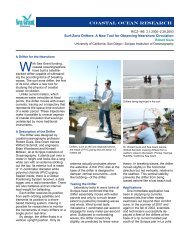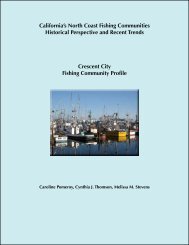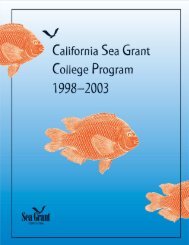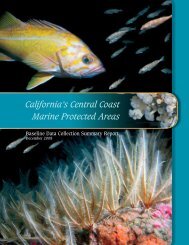2001â2002 - California Sea Grant - UC San Diego
2001â2002 - California Sea Grant - UC San Diego
2001â2002 - California Sea Grant - UC San Diego
Create successful ePaper yourself
Turn your PDF publications into a flip-book with our unique Google optimized e-Paper software.
survey, the <strong>California</strong> legislature has banned the importation, possession<br />
and intrastate sale of nine Caulerpa species, three of which are known to<br />
be invasive and six of which are nearly indistinguishable from the invasive<br />
varieties. The interstate sale of C. taxifolia is illegal under the Federal<br />
Noxious Weed Act of 1999.<br />
The third <strong>Sea</strong> <strong>Grant</strong> project targeted public education—perhaps the<br />
single most important component of the SCCAT team’s eradication<br />
strategy, because unlike other invasive species, the general public can<br />
introduce and spread Caulerpa. It is believed that Caulerpa was introduced<br />
to Southern <strong>California</strong> by residents who had emptied their home<br />
aquaria into nearby waterways. Boating, recreational diving and fishing<br />
can also spread Caulerpa, because tiny torn fragments of Caulerpa have<br />
the capability of growing into entire new plants.<br />
To educate the public about the seriousness of Caulerpa and other<br />
marine exotics, <strong>Sea</strong> <strong>Grant</strong> collaborated with the Birch Aquarium in La<br />
Jolla and funded biologist Dr. Enric Sala of Scripps Institution of Oceanography<br />
to create a colorful, educational exhibit on Caulerpa. The display—a<br />
5- by 10-foot panel—shows people what Caulerpa looks like,<br />
explains the dangers of releasing home tanks into waterways and explains<br />
how even microscopic Caulerpa fragments can grow quickly into new<br />
adult plants. The public was also alerted to the importance of reporting all<br />
Caulerpa sightings to appropriate agencies. The exhibit is on display at<br />
the Birch Aquarium.<br />
Despite the best efforts of the<br />
groups involved, as of mid-2002,<br />
Caulerpa had not been eradicated<br />
at either the Agua<br />
Hedionda or Huntington<br />
Harbour. As part of its ongoing<br />
effort help expunge the seaweed,<br />
<strong>Sea</strong> <strong>Grant</strong> co-sponsored the first<br />
international workshop on C.<br />
taxifolia, held in <strong>San</strong> <strong>Diego</strong>,<br />
January 31–February 1, 2002.<br />
The meeting was attended by a<br />
blue-ribbon panel of scientists<br />
and resource managers from six<br />
countries, including France, New<br />
Zealand, Australia and Croatia,<br />
as well as by local agencies, city<br />
officials and planners involved in<br />
the Southern <strong>California</strong> cleanup.<br />
Among the many positive<br />
outcomes of the workshop,<br />
A Caulerpa taxifolia frond. Possession of<br />
these once popular aquarium plants is<br />
now illegal in <strong>California</strong>. Photo: Lars<br />
Anderson, Weed Science Program,<br />
<strong>UC</strong> Davis<br />
resource managers were able to discuss the merits of different eradication<br />
schemes and from these interactions, to identify further research needs.<br />
17











